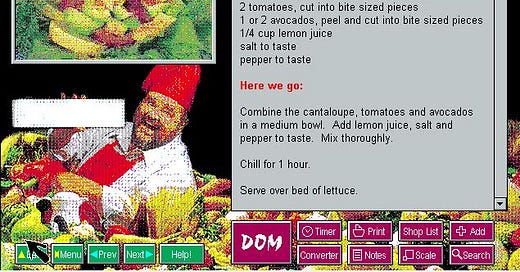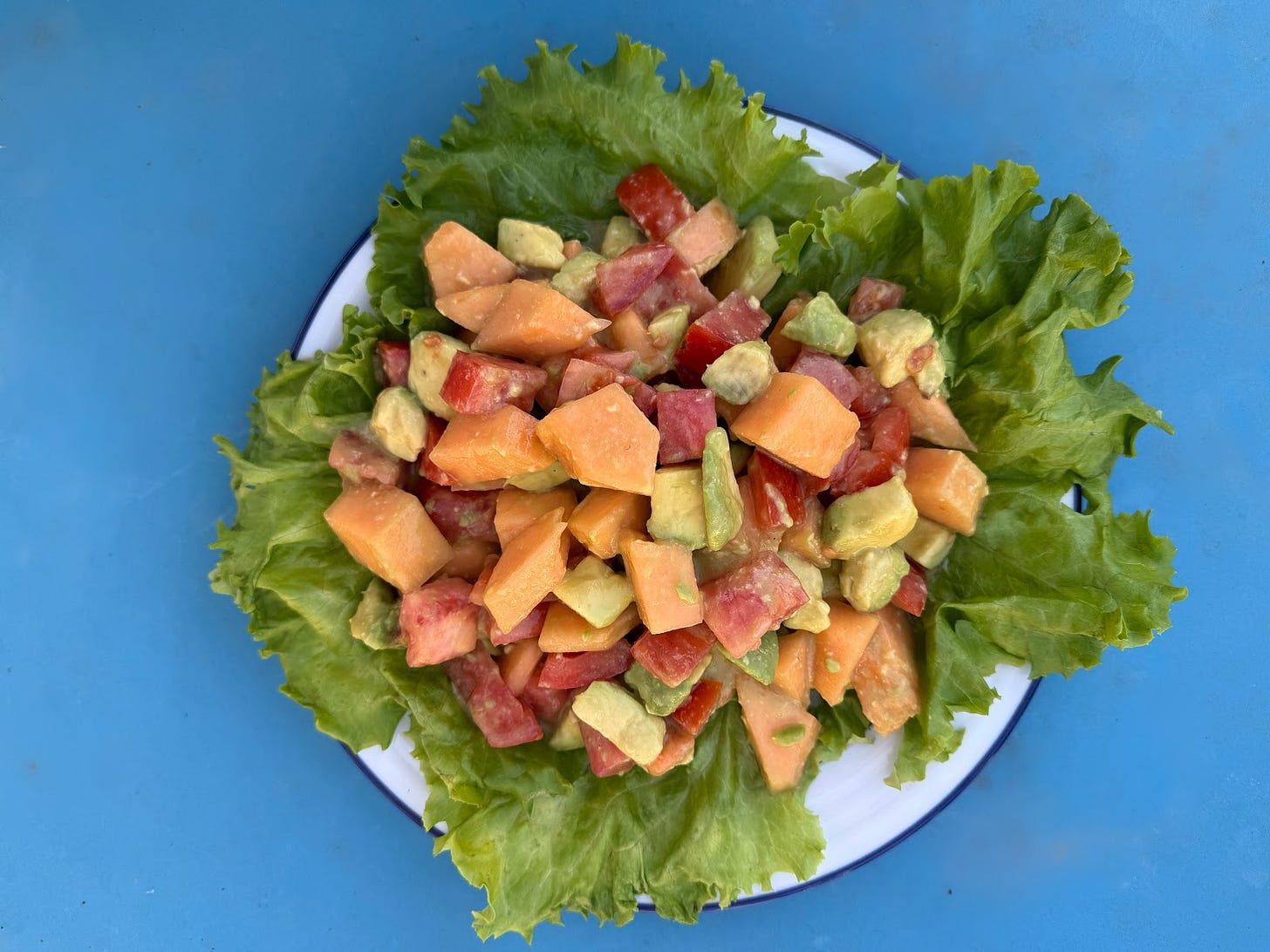Digital distribution has ruined many things, but chief among them is the joy of discovery. I miss browsing the software bargain bin at Best Buy (call it Windows shopping) for hyper-niche treasures. I miss reading the backs of game boxes like dust flaps on a book.
Estate sales are the closest you can get these days, but they come with the baggage of raiding someone’s burial mound. It was on one of these raids where I stumbled upon Cooking with Dom DeLuise (1995), a two-disc CD-ROM set from Allegro New Media.
I have long felt a kinship with the actor Dom DeLuise, who I recognize as a fellow gremlin of appetite and delight. Dom was an enthusiastic ham in movies like Blazing Saddles and Robin Hood: Men in Tights, but he was also a ham enthusiast, with two physical cookbooks and one digital one. I couldn’t help but admire a man who looked like Paul Prudhomme, clowned like Paul Reubens, and displayed a lifelong commitment to dismantling his own gravitas. A few years ago, I gave a talk on criticism that required a headshot, and I asked the organizers to use a photo of Dom DeLuise instead.1
Cooking with Dom DeLuise, then, was an irresistible artifact. There was only one problem: technology has advanced modestly since 1995, and I could not play the 20-year-old CD-ROM on my PC. Instead, I had to mount it in VirtualBox, a piece of open-source software for running virtual machines, using an image of Windows 95 that I downloaded with zero concern for the safety of my computer.
This took me an embarrassingly long time to do. I do not describe myself as “technologically savvy,” but I do not describe myself as “savvy” in general. When I finally got to the loading screen, I felt a rush of accomplishment I have not felt since 2013, when a fiction professor described my work as “willfully obtuse.”
Cooking with Dom DeLuise is an encyclopedia of both culinary and foley arts—think Microsoft Encarta with a whoopie cushion. The dishes are an eclectic blend of competent Italian classics, ‘90s mod-slop, and stolen valor such as “My Agent Robert’s Wife Jeannie’s Gefilte Fish” (serving size: 120).
Each recipe is accompanied by a video clip with a 30-pixel resolution and a frame rate of two. A few of them capture Dom actually talking about the dish on the screen, but many are just soundtracked by his deviant chuckles. I have transcribed a few of them below.
“Hee-HEE!”
“HOOO-ha-ha-ha! Pfffbbbbbttt”
“OOOOH hohohoHO ya-YAA-yaa.”
Mostly, there are fart noises.
At the bottom of each recipe is a button simply labeled “DOM,” which you can press at any moment to rotate through one of dozens of catchphrases.
“WOW, is that delicious?” you can make Dom say. “Piping hot, and it is so good.” This is admittedly confusing when laid over a recipe for an iceberg salad.
Cooking with Dom DeLuise was not a smash hit—the business plan for these early multimedia cookbooks was ultimately stymied by the fact that no one had yet invented a computer they could take into the kitchen.
Dom winks at this in a section of videos titled “Computer Cutups,” where he offers impractical, mostly facetious kitchen tips—say, juicing lemons with the tray from the CD drive. If nothing else, it’s a nostalgic look back to an era when people had more faith in the strength of consumer electronics. We watch breathlessly as Dom “cracks walnuts” by bludgeoning them with his keyboard, as he grinds herbs in a molcajete with a computer mouse.
Less explicable is a collection of videos titled “The International Diner,” in which Dom impersonates the sounds of a dozen languages, from Japanese to Ethiopian to Swedish. Why was this included? It is not for us to know. Pre-broadband media was destined to Age Badly, largely because it was not designed to age.
Some of the recipes similarly feel like time capsules—say, Dom’s “Strange but True Salad,” which lives in the uncanned valley between a fruit salad and a guacamole someone forgot to finish.
I was compelled to make it by the accompanying photo of brightly colored shapes. I immediately drove to the Hy-Vee to hunt for out-of-season tomatoes and the ripest cantaloupe I could find.

The salad tasted exactly like the 1990s, which is to say: like an idea that someone might later come along to refine. It looked like a bunch of colors and shapes. I liked it! The lemon juice kept the avocado from browning, the tomato added body to the dressing, and the cantaloupe made everything taste like cantaloupe.
The Italian recipes feel more timeless—chicken cacciatore, pasta e fagioli. One recipe—the “Fastest Sauce in the West”—simply calls for doctoring a jar of Paul Newman’s tomato sauce with extra garlic and oregano. I don’t think Dom’s trying to own Newman, but the implication seems clear: anyone with a jawline that chiseled is too prone to restraint.
Ultimately, Cooking with Dom DeLuise has a culinary aesthetic that’s neither trendy nor aspirational—less Crate and Barrel, more CompUSA. Its deliberate un-sleekness feels like an antidote to the Giada deLaurentises, the Stanleys Tucci. Who today would dare to wear a chef’s toque the color of a clown nose? Who among us has the courage to bring buffoonery to the buffet?
I worry about these things as someone with a niche newsletter that, like Cooking with Dom DeLuise, seems designed for a bargain bin. We have so few bargain bins left! I suppose the drive toward optimization and efficiency is a net good, but I like a good that’s gross.
It is time, I think, to recover what we’ve lost. It is time to manifest the menu we deserve. The era of self-serious sex symbols trying to min-max dinner is over. Welcome to the era of Big Goons Making Goon Food.
Haterade is a free newsletter sustained by the intoxicating aroma of cantaloupe. Sharing a post is a great way to mimic the Bargain Bins of yore and get this niche content in front of the weirdos who might appreciate it. If you’d like to support the newsletter, you can become a paid subscriber (no perks! no rules! perfect vibes!) or stuff some money in the tip jar here: Venmo | PayPal
They did.








Though I’m not a full-stack development enthusiast per se, I think I likely washed up here on the edges of the Hacker News wave, since I was linked to your rodent repelling tape article by a friend in cyber security. (Instantly hooked, and my first internet reading binge in a long time.)
Now, I am pleased to report that your Dom DeLuise post led me to the Wikipedia article on cantaloupe, and the intriguing claim that “A moldy cantaloupe in a Peoria, Illinois, market in 1943 was found to contain the highest yielding strain of mold for penicillin production”. I really cannot over stress that this tidbit was, as of April 30, listed under Uses > Culinary!
I love that Pete Townshend once rhymed "memories" with "Dom DeLuise." https://www.youtube.com/watch?v=2LK_T-hBEgk